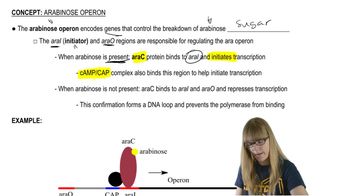The diagram below shows a DNA duplex. The template strand is identified, as is the location of the nucleotide. Assume this region contains a gene transcribed to form mRNA in a eukaryote. Identify the location of the most common promoter consensus sequences. <>
 Sanders 3rd Edition
Sanders 3rd Edition Ch. 8 - Molecular Biology of Transcription and RNA Processing
Ch. 8 - Molecular Biology of Transcription and RNA Processing Problem 4
Problem 4Identify similarities and differences between an inducible operon and a repressible operon in terms of
the transcription-regulating DNA sequences.
 Verified step by step guidance
Verified step by step guidance
Verified video answer for a similar problem:
Key Concepts
Operons

Inducible Operons

Repressible Operons

The diagram below shows a DNA duplex. The template strand is identified, as is the location of the nucleotide. If this region is a eukaryotic gene transcribed by RNA polymerase III, where are the promoter consensus sequences located? <>
The diagram below shows a DNA duplex. The template strand is identified, as is the location of the nucleotide.
Assume this region contains a gene transcribed in a bacterium. Identify the location of promoter consensus sequences and of the transcription termination sequence. <>
The following is a portion of an mRNA sequence: 3'-AUCGUCAUGCAGA-5' During transcription, was the adenine at the left-hand side of the sequence the first or the last nucleotide used to build the portion of mRNA shown? Explain how you know.
The following is a portion of an mRNA sequence: 3'-AUCGUCAUGCAGA-5' Write out the sequence and polarity of the DNA duplex that encodes this mRNA segment. Label the template and coding DNA strands.
The following is a portion of an mRNA sequence: 3'-AUCGUCAUGCAGA-5' Identify the direction in which the promoter region for this gene will be located.